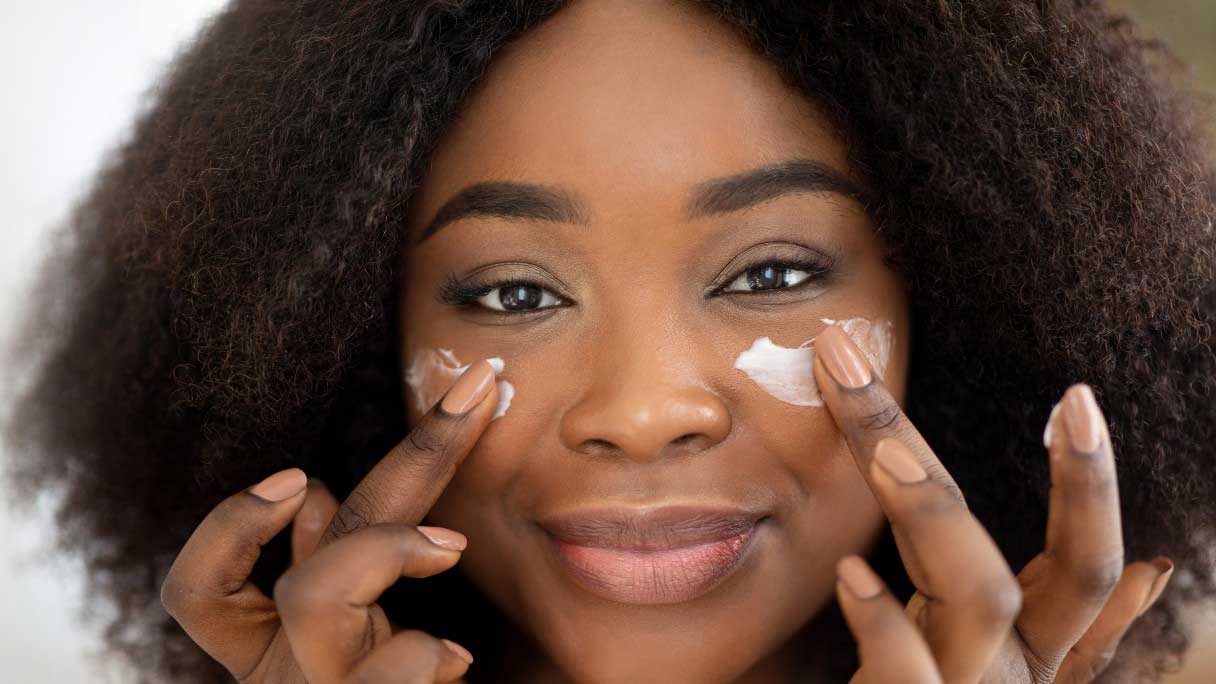Want to see quicker results from your skincare routine? Consider adding in a facial serum. These potent powerhouses can deliver big results from a tiny bottle.1 Learn more about the different kinds of serums, their benefits and how to find the best facial serum for you.
What Are Facial Serums?
Facial serums are skincare products that have a higher dose of active ingredients like vitamin C, retinol or hyaluronic acid for more potent effectiveness. Facial serums are often lighter weight than lotions, allowing them to be layered under a moisturizer and to penetrate more deeply into the skin. A basic skincare routine often includes a cleanser, a moisturizer and sunscreen.2 If you're looking to address specific skin concerns such as dullness, hyperpigmentation, acne or fine lines, you might want to add a facial serum into your routine.1
The Benefits of Using a Facial Serum
Facial serums can offer the skin a number of benefits that are often beyond the reach of a basic cleanser or moisturizer. The benefits of facial serums include:1
- Quick absorption
- Lightweight consistency
- Higher concentration of active ingredients
- Protective qualities
- Designed to address specific skin concerns
- Can be layered
Types of Facial Serums and Their Benefits
There are a wide range of facial serums designed to address specific skin concerns such as dullness, adult acne, fine lines or dryness.1
| Serum Type | Serum Benefits | Serum Ingredients |
|---|---|---|
|
Anti-aging/Firming |
Soften fine lines and wrinkles Promote cell turnover Firming Hydrating |
Retinol/Vitamin A Niacinamide/Vitamin B3 Bakuchiol Peptides |
|
Skin brightening |
Fade sunspots and hyperpigmentation Even skin tone |
Vitamin C Vitamin E Green tea Kojic acid Ferulic acid |
|
Anti-acne |
Prevent acne Unclog pores Absorb excess oil Face acne scars and hyperpigmentation |
Alpha-hydroxy acid (AHA) like glycolic acid Beta-hydroxy acid (BHA) like salicylic acid Zinc Tea tree |
|
Hydrating |
Extra hydration |
Hyaluronic acid Ceramides Facial oils like argan, jojoba Glycerin Aloe Rosewater Sea kelp |
|
Exfoliating |
Encourage cell turnover Unclog pores Smooth the skin Soften fine lines and wrinkles |
Glycolic acid Lactic acid Retinol Citric acid |
|
Renewing/Antioxidant |
Support skin's epidermis Maintain skin's moisture Protect against free radicals |
Antioxidants Ceramides Green tea Resveratrol Seaweed |
Combination serums can address multiple issues at once. Facial serums can also be marketed for specific areas of the body, including those designed to treat the area around the eye or the neck.
How to Choose the Right Facial Serum
Finding the right facial serum for you will start with considering what skin issues you want to address. If you are concerned with dull skin, consider an exfoliating serum. Fine lines and wrinkles? An anti-aging serum. Added moisture? A hydrating serum. Within each type of facial serum, specific product descriptions, customer reviews and trial-and-error can help you narrow down the best active ingredients for your skin.1
As with most skincare products, seeing results from facial serums will take both consistency and patience. The American Academy of Dermatology Association recommends using a product for at least 30 days to determine its effectiveness.3
How to Apply a Facial Serum
Skincare products should be applied in order from the thinnest to the thickest products. This allows thinner, more potent products like facial serums with a higher concentration of active ingredients to penetrate into the skin and thicker skincare products like moisturizers or sunscreens to provide a protective barrier to the skin, locking in moisture or providing protection from the sun.4
After cleansing, gently apply two to three drops of a facial serum to the skin. Although a small amount, serums spread easily due to their thin consistency and contain a higher amount of active ingredients than cleansers or lotions.5
In general, protective serums like antioxidant and hydrating serums are best used in the morning; exfoliating and anti-aging serums should be used at night, as these facial serums can make the skin more sensitive to the sun's rays.6
Facial serum combinations to avoid
While many facial serums can be used together, some skincare ingredients shouldn't be combined. The competing ingredients may cause irritation or even cancel out the benefits of each product when used together. Consider using serums with these ingredients on different days or separate between morning and night.7
- Retinol and vitamin C
- Retinol and alpha hydroxy acid (AHA)
- Retinol and benzoyl peroxide
- Retinol and salicylic acid
- Mixing multiple AHAs (glycolic, lactic and malic acids)
How to Store Facial Serums
Because facial serums often contain higher concentrations of active ingredients, they can also be more sensitive to their environment. Contact with heat, light and air can cause facial serums to oxidize, break down or decrease their effectiveness. Store your facial serums in a cool, dark, dry place and avoid purchasing large amounts that may lose effectiveness before you finish the product.8
Where to Buy Facial Serums
Facial serums can be purchased at local drugstores, specialty skincare stores, medispas and dermatologist offices. Your budget, brand preference and comfort level may determine where you purchase your skincare products. You may want to consider if the location offers one-on-one help selecting skincare products based on your concerns or if they allow returns for products that don't work for your skin.
Average Cost of Facial Serums
From vitamin C to glycolic acid to ceramides, facial serums can have a wide price range depending on where you purchase them, the specific brand, the potency and other included ingredients. Most facial serums can be found from under $20 at drugstores, $50 to $100 at beauty and specialty stores to more than $200 for facial serums from luxury brands.
Keep in mind that buying a more expensive serum doesn't always equate to it being more effective. When choosing a facial serum, be sure to consider the concentration and potency of active ingredients.9
Financing for Facial Serums with the CareCredit Credit Card
The CareCredit credit card makes it easy to pay for dermatology visits, over-the-counter treatments, and prescription medications at locations within the CareCredit network.* Start investing in your skin today and apply for the CareCredit credit card. Find a dermatologist near you that accepts CareCredit and continue your wellness journey by downloading the CareCredit Mobile App to manage your account, find a provider on the go and easily access the Well U hub for more great articles, podcasts and videos.
Author Bio
Kate Bayless is a health and wellness freelance writer with 15 years of experience. Her work has appeared in Parents, Women's Health, Beachbody and OpenFit.








